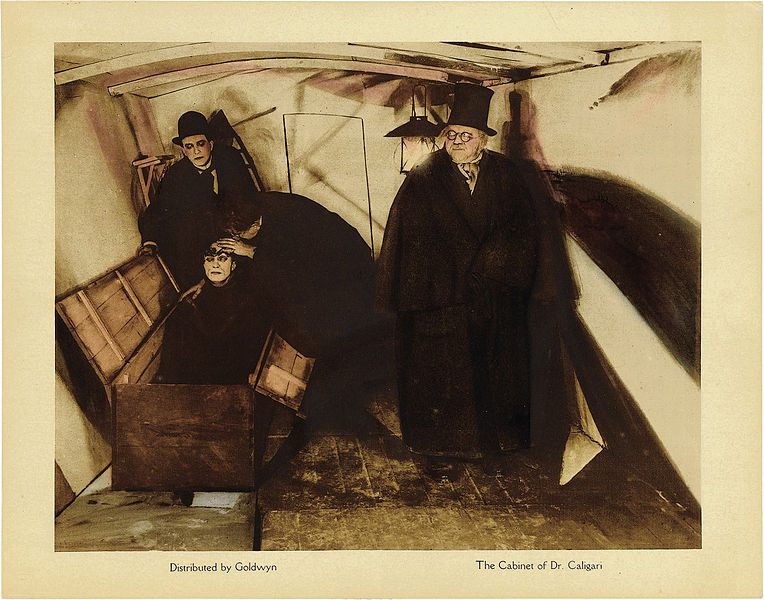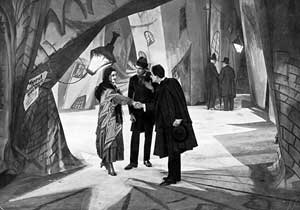The Mad Doctor Meets the Somnambulist
Vad som händer är den första kommersiellt framgångsrika konstfilm. Det kabinett av Dr. Caligari (1920) släpptes i januari 1920 bli en tysk och internationell sensation. Det markerade början på den tyska filmväckelsen under 1920-talet
The German Expressionist Movement in German art strongly influenced this film. Expressionistiska målare ritade byggnader som lutade i udda vinklar, oddly shaped furniture, etc..
The film’s set design reflected this style of composition. Buildings, doors and streets all slope at odd angles or are irregular shapes. Furniture is also oddly shaped. Chairs seats are six feet in the air, bookcases lean and chairs have irregular backs.
Robert Weine filmed in a standard continuity format making the story understandable to the average viewer. The story itself is a horror and detective story told from one man’s perspective, a story within a story.
A mysterious stranger named Dr. Caligari, spelad av Werner Krauss, kommer till Hollstenwall för att visa upp en somnambulist Cesare, spelad av Conrad Veidt. A somnambulist sleeps for days on end. Calagari säger att Cesare har sovit för 20 till 30 år. Coincidentally or not, a series of murders occur once Caligari and Cesare arrive in Hollstenwall.
The protagonist of the film is Francis (Friedrich Feher), who is in love with Jane (Lil Dagover). En okänd djävul mördar Francis’ vän som leder Francis att förfölja Dr. Caligari, som Francis tror är ansvarig för mordet.
Den ständiga spänningen mellan Francis och Caligari driver berättelsen, which is complicated by Cesare’s infatuation with Jane, Francis’ love interest.
Weine filmade ett twist-slut I won't spoil for you. Hans Janowitz och Carl Mayer skrev filmen och motsatte sig starkt Weines förändringar. Weine trodde inte att publiken skulle acceptera filmen utan twist-slutet.
You will want to view this movie on the Special Collector’s Edition DVD, which restored the film to its original speed of 18 feet per second. American films were shot at 24 feet per second. When the original copies for video distribution were made, a copy of the film was recorded on a 24 feet per second projector. The recording at a different speed made the film look a bit quirky and rushed. The film actually has a very deliberate pace, when viewed at the proper projection speed.
The Expressionist scenery will distract you at first. When I first watched the film about ten years ago for a college class, my wife and kids thought I was watching some 1960s psychedelic drug film. Even after explaining Expressionism, they thought it was odd. All three of my children have watched the film to mixed reviews. I will let you decide on the film yourself.
Uppdatera: I recently saw the restored version on Netflix. I recommend this copy also.
You can leave a comment or ask a question about this or any post on my Facebook-sida.
Nåla Det



